What is Blue Ocean Strategy? A Quick Guide to Innovation and Market Creation
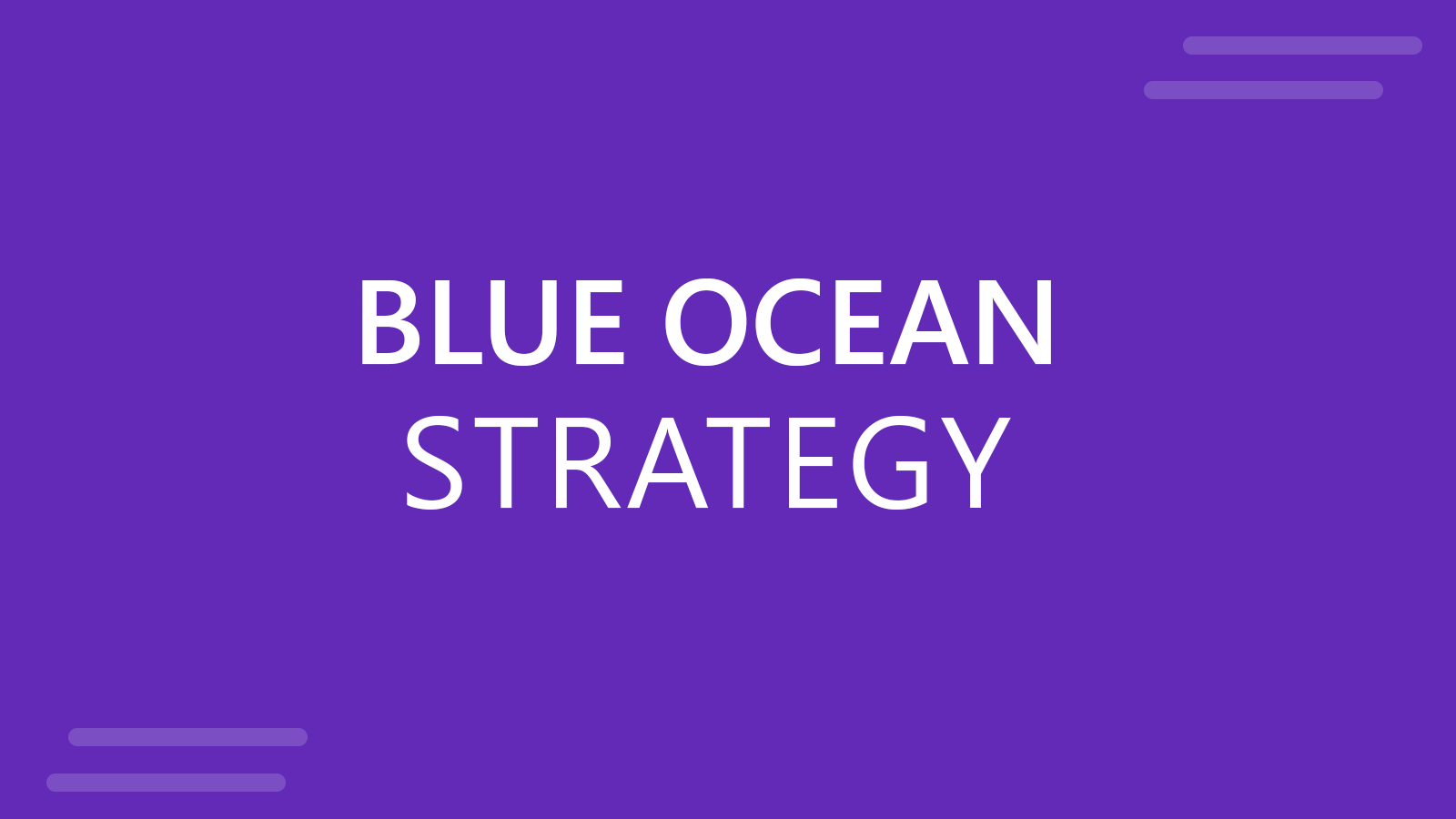
World markets are saturated with fierce competition. This competition has been increasing in the wake of global market integration, digital marketplaces, and the ability for consumers to look for products and services not only locally but on a global scale. Competing in such markets can be quite difficult, since the conventional markets or red ocean is filled with competitors that have gained a foothold for their market niche. However, the Blue Ocean Strategy provides breathing space to venture beyond cutthroat competition into something new and unique.
What is Blue Ocean Strategy?
Moving away from the conventional focus of beating competitors to gain a foothold in a market, the Blue Ocean Strategy emphasizes developing new markets, making competition irrelevant. This competitive strategy focuses on innovation, looking for untapped potential by catering for gaps in customer needs, breaking free from competitive markets.
The concept of Blue Ocean Strategy was developed by Chan Kim and Renée Mauborgne, based on the very idea of ‘value innovation’. Some examples include Apple’s iPhone which introduced a new type of phone in the market at the time, revolutionizing the concept of what a mobile phone can do or the way it can be used. Its launch in 2007 marked the launch of the ‘smartphone’, making it a unique product at the time. Other Apple products such as the iPod launched much earlier in 2001 and the iPad in 2010 are other examples of the Blue Ocean Strategy at play.
In the wake of globalization coupled with access to digital technology and the internet, the Blue Ocean Strategy has been relevant more than ever before. With new businesses and concepts springing up regularly in the form of digital devices, virtual products, and due to access to wide markets. From the redefining of the traditional circus by Cirque du Soleil to the launch of Uber, Airbnb, Tesla’s electric vehicles, and even Zoom bursting on the global scene as a remote meeting service provider, the products emerging from the Blue Ocean Strategy concept have been integrating in our lives more than we might realize.
Red Ocean vs Blue Ocean Strategy
Unlike Blue Ocean Strategy, Red Ocean Strategy is based on focusing on competitive markets, beating the competition to make space. Below is a comparison of the Red Ocean Strategy vs the Blue Ocean Strategy.
Red Ocean Strategy
- Emphasizes on beating competition by increasing the market share of an existing, competitive market.
- A Red Ocean Strategy is a zero-sum game, where the gain of one company is another company’s loss, competing for a shrinking pie.
- Red Ocean Strategy includes markets where competition intensifies as the market saturates. This usually leads to price wars, reduction in profitability, the challenge to differentiate your product, until the market might not be viable for competitors who are competed out.
Blue Ocean Strategy
- The goal of the Blue Ocean Strategy is to look for ‘blue oceans’ or the untapped potential where there aren’t any customers but an unmet need that can be catered for.
- Something similar to the Red Ocean Strategy in the Blue Ocean Strategy is the focuses on differentiation, however, with also focus on innovation. The company creates a unique value that people will be willing to pay for. Such as the iPhone, which provided something more than just a phone for making calls or sending short messages.
- Blue Ocean Strategy directs innovation in an area that is not crowded, leading to sustainability and profitability, at least until the market becomes saturated with competition.
The Blue Ocean Strategy offers a number of tools that can help you systematically look for creating new markets and tapping into unmet customer needs. Below are some commonly used tools for this competitive strategy, developed by Chan Kim and Renée Mauborgne.
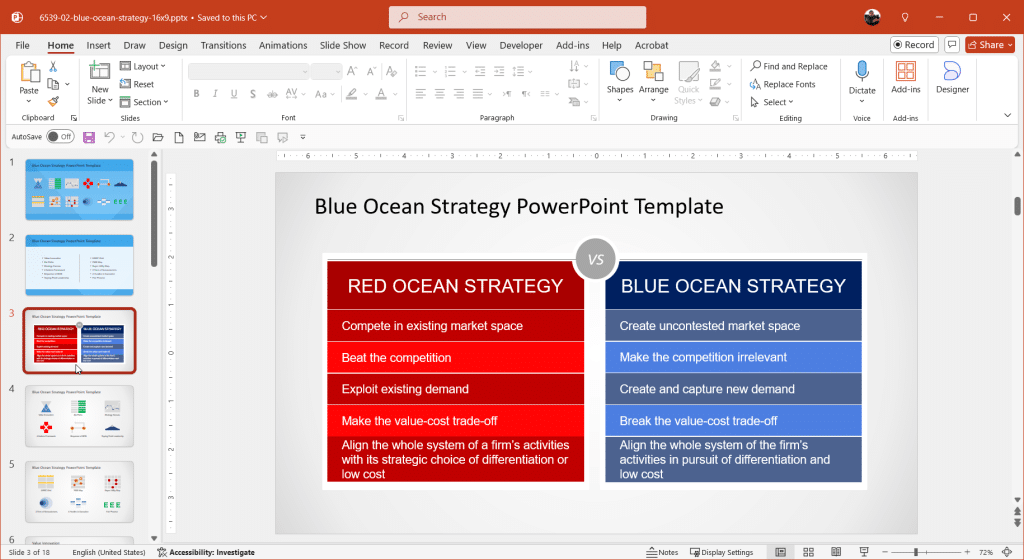
1. Strategy Canvas
The Strategy Canvas is a tool that is used to visualize and analyze the current market landscape by plotting key factors along the horizontal axis such as features, pricing, and service, whereas the vertical axis plots performance levels. The Strategy Canvas was developed by Chan Kim and Renée Mauborgne as a one page for visual analytics related to understanding the market and how you can fill unmet needs through your unique value proposition.
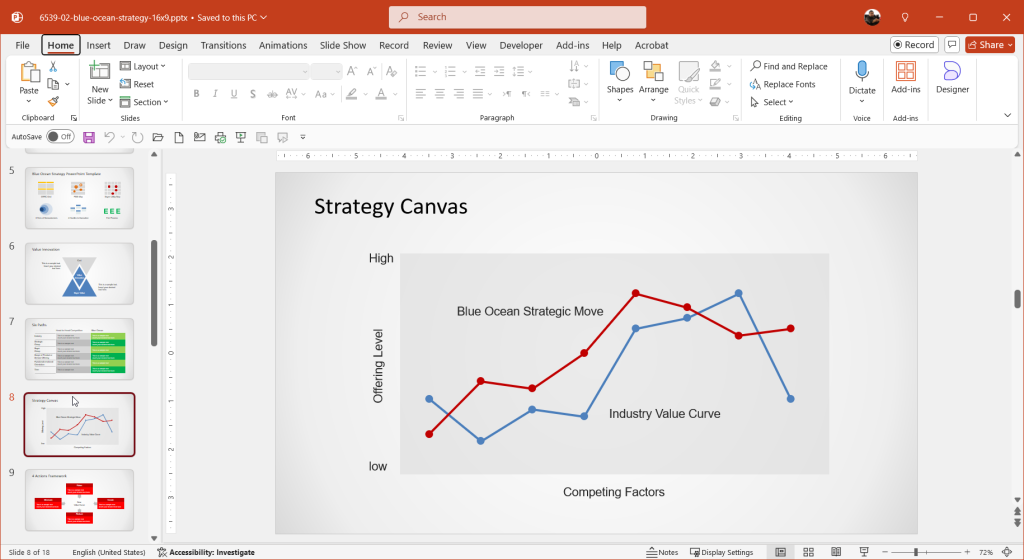
If you need to present a strategy canvas to an audience, you can use a pre-made strategy canvas PPT template.
2. The Four Actions Framework
The Four Actions Framework provides four key questions to alter the factors upon which companies are engaged in competition. Below is an explanation of the four key questions with the example of the iPhone as a product that aptly fits the Four Actions Framework.
Eliminate: The first question is regarding the elimination of factors that an industry takes for granted. An example is the iPhone, which came with a touchscreen to eliminate the need for using the physical keyboard on conventional phones at the time. This meant that there was no need to press a button multiple times to type a single letter.
Reduce: This question is meant to determine which factors should be reduced below the standards of an industry. The iPhone reduced the multiple buttons that were standard for the mobile phone industry at the time. The buttons were replaced with Home, Power and Volume keys, with a touchscreen interface.
Raise: This ‘raise’ factor is a matter of questioning which standards can be raised above industry standards. The iPhone raised industry standards in many ways. Such as by offering the proprietary iOS laden with new apps, a touchscreen interface, and the ability to integrate a phone, media player, internet browser, and other features, the iPhone was able to raise industry standards to an unprecedented level.
Create: This is the question about what innovation can be added to create something that the industry has not offered before. While other phones provided the ability to browse the internet, the Safari browser and mobile apps provided by iPhone were far superior in terms of user experience. Not to mention, other mobile phones could not match its ability to play multimedia content, and to access apps and features similar to a laptop.
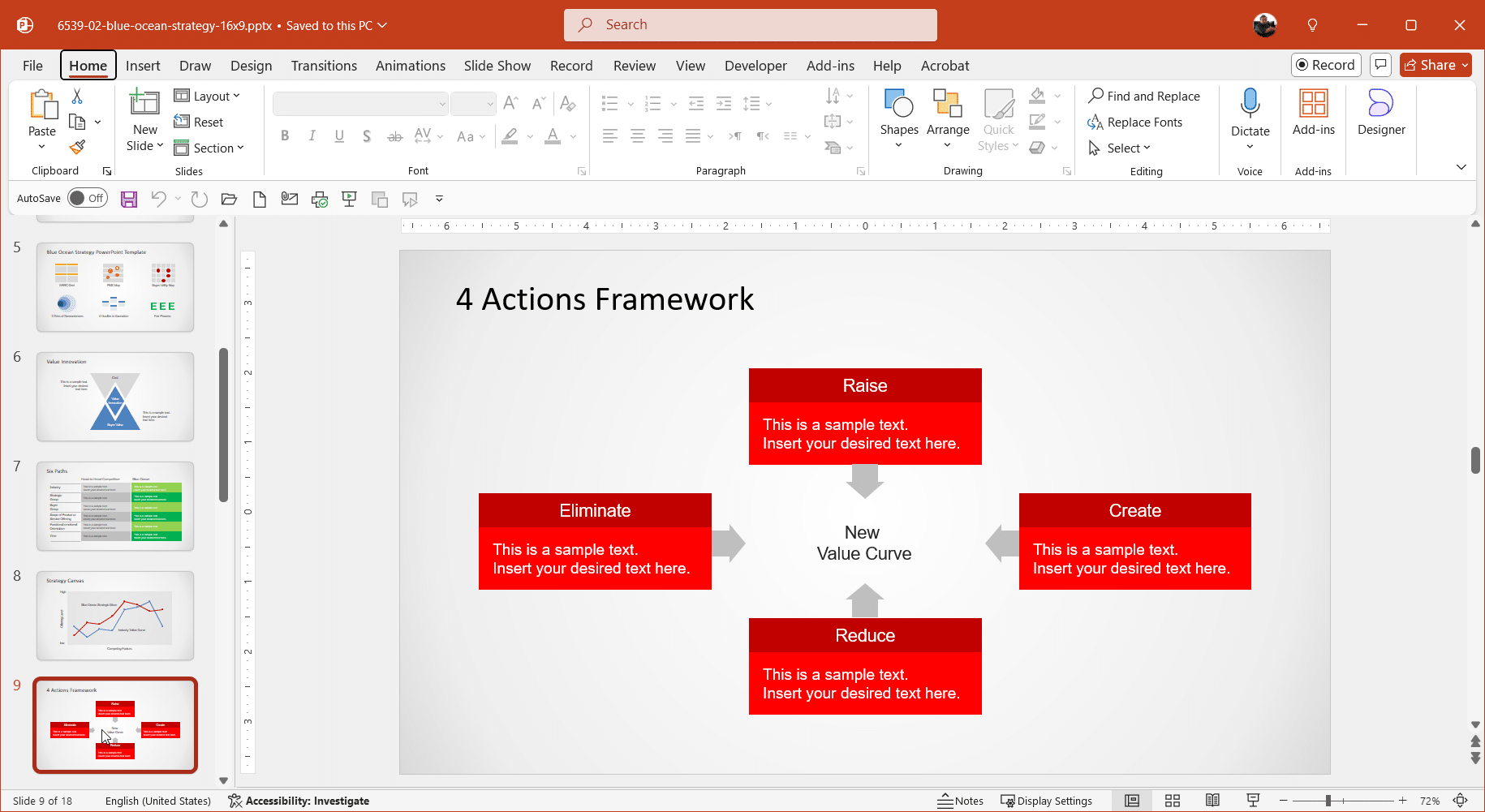
3. The Six Paths Framework
The Six Paths Framework is a tool that helps explore opportunities beyond the boundaries of the traditional market. The tools encourages looking into six paths for creating a market including:
1. Look across alternative industries to see what can be offered as an alternative.
Example: Airbnb did not compete with the saturated hospitality industry but rather provided the opportunity to explore the local culture through a chance to experience the local lifestyle by allowing people to rent out their space.
2. Look across strategic groups in an industry.
Example: Netflix combined the concept of DVD rentals and traditional TV to make movies, TV shows, documentaries, and children’s entertainment programs accessible through its platform.
3. Look across the chain of buyers.
Example: Apple not only attracted customers to buy its product but also created an ecosystem for developers to create and sell apps through its app store. Making it possible for buyers to not only buy the iPhone but also apps through its app store to personalize their devices.
4. Look across complementary services and products.
Example: Tesla through its electric cars not only created a market for luxury EVs but also enabled generating, storing and using renewable energy for home consumers through the Tesla Powerwall with home energy storage and solar panels.
5. Look across appeal, such as functional or emotional appeal.
Example: While traditional TV channels had schedules and limited time to view movies and TV shows, Netflix introduced a way to access entertainment at a time convenient for the consumer, based on their time, mood, and preferences.
6. Look across time.
Example: Shifting consumer preferences and needs can be a major factor over time. Since time plays a major role in how industries are shaped and understanding this can be key. Nokia failed to see the change, focusing for a long time over the Symbian OS and outdated products, whereas companies like Apple and Samsung made progress with new and innovative features for phones, constantly redefining how the industry evolved. Recent examples include the infinity display, Samsung’s flip phones like the Galaxy Z Fold and Galaxy Z Flip, with recent focus by the company on AI and integrating 5G technology in its phone.
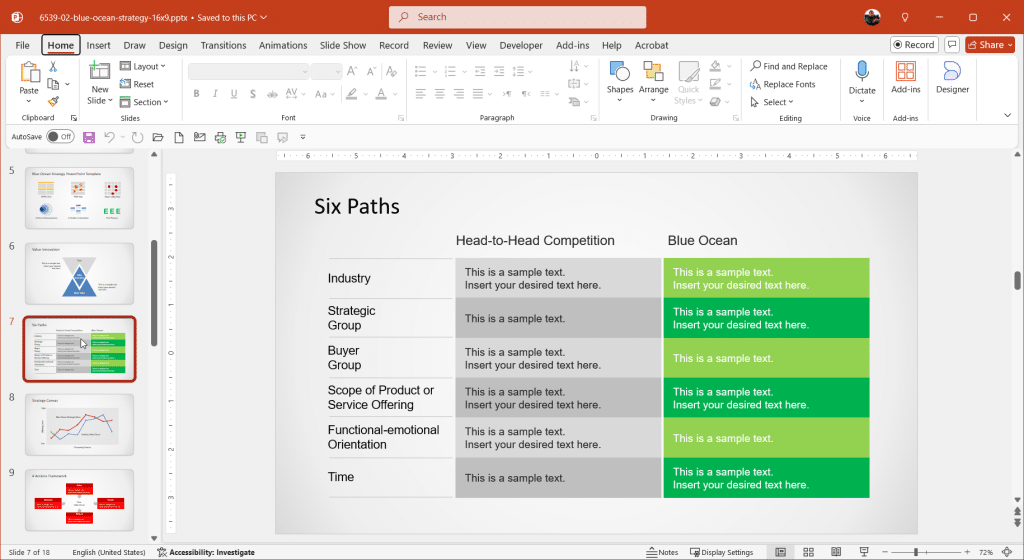
4. Eliminate-Reduce-Raise-Create (ERRC) Grid
The Eliminate-Reduce-Raise-Create (ERRC) Grid provides a structure by complementing the Four Actions Framework by encouraging organizations to sort out what to eliminate, reduce, raise, or create in the industry to create their unique value proposition.
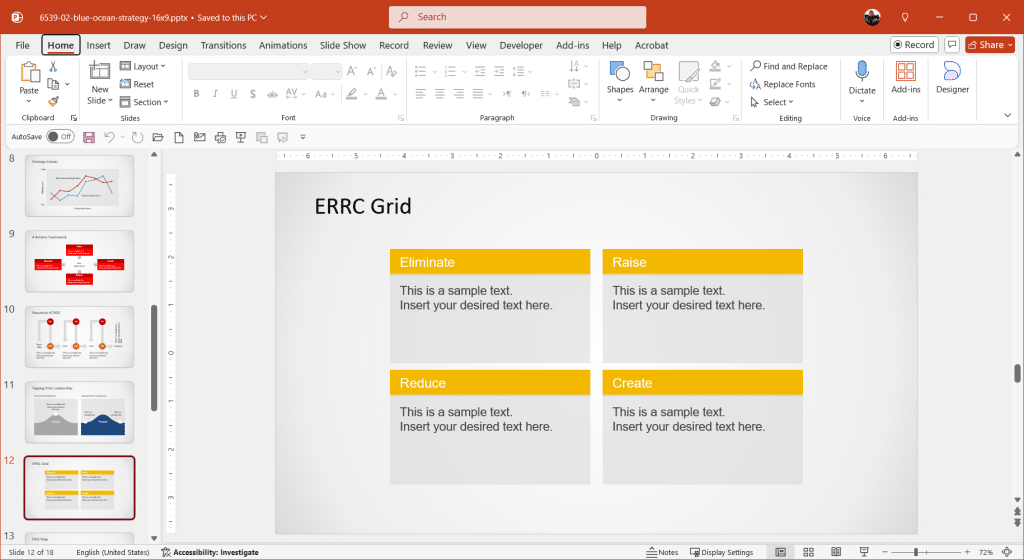
5. Buyer Utility Map
The Buyer Utility Map helps explore the product lifecycle with focus on six utility levers including, the productivity, simplicity, risk, convenience, fun and image, and friendliness in terms of environment. This helps to identify the unique value to account for to cater to customer needs.

6. Pioneer-Migrator-Settler (PMS) Map
The Pioneer-Migrator-Settler (PMS) Map is used to plot a company’s existing portfolios to assess offerings based on their innovative value for customers for analyzing the strategic value of the portfolio. The map is divided into three sections, including:
Pioneers: These are innovative products or services that create the blue oceans or new markets.
Migrators: These include improvements to existing markets, offering better value.
Settlers: These are products or services that replicate in some way the current market offerings, with a differentiation that makes them stand out.
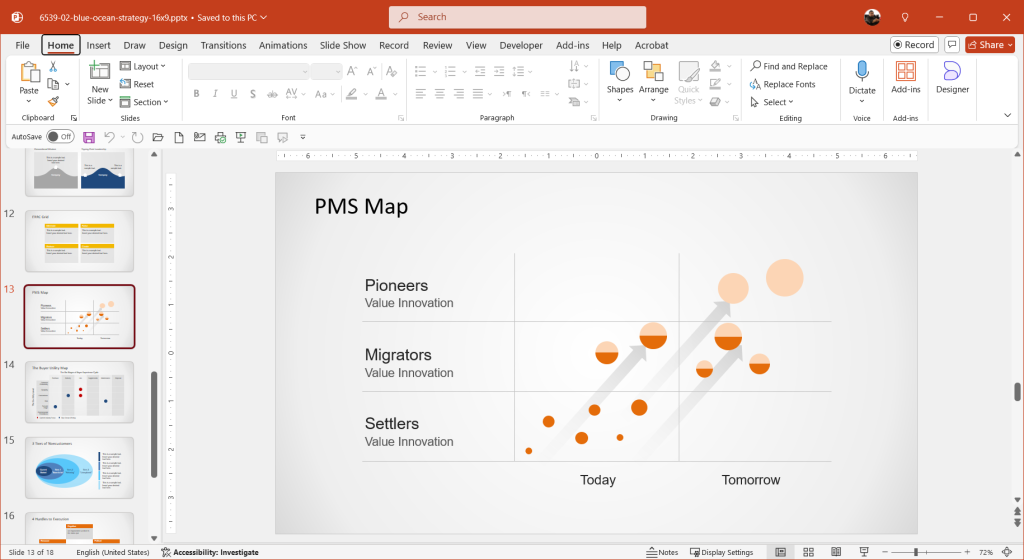
Blue Ocean Strategy PowerPoint Template
To showcase your Blue Ocean Strategy, you can use this Blue Ocean Strategy PowerPoint template that covers the six tools for a strategy including, the Strategy Canvas, Four Actions Framework, Six Paths Framework, ERRC, Buyer Utility Map, and PMS Map. The template also provides various slides for discussing Red vs Blue Ocean Strategy, and other aspects of innovative products or services.
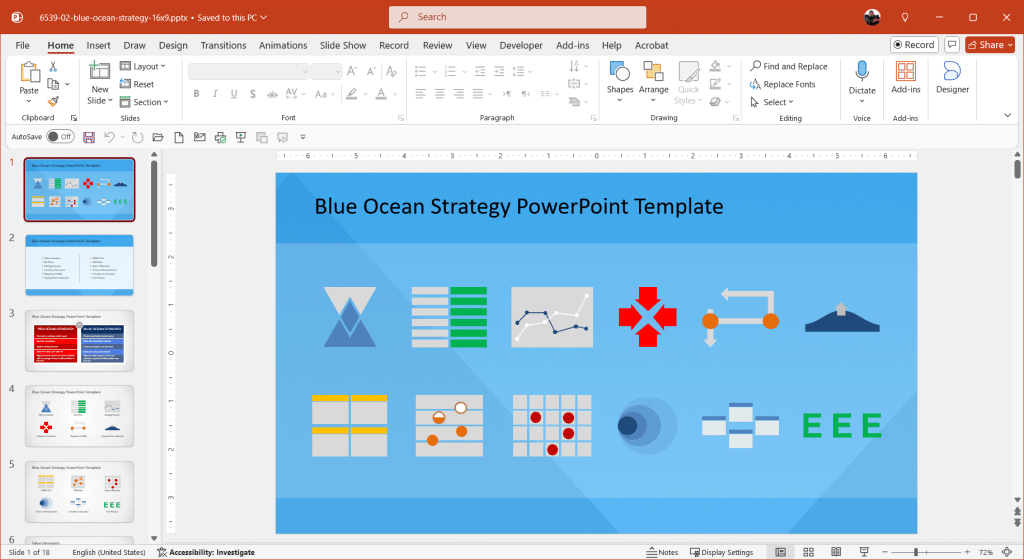
Final Thoughts
The Blue Ocean Strategy has been used by startups, medium size, and large-scale companies with a considerable amount of success. By tapping into unmet needs and creating demand for new products and services, the strategy can be effective in exploring new markets for sustainable and profitable ventures. However, before moving ahead with the development of a product or service, it is essential to consider market needs and the various tools the strategy offers to understand and visualize the current market, anticipated needs, user demands, gaps, etc.
We will send you our curated collections to your email weekly. No spam, promise!
